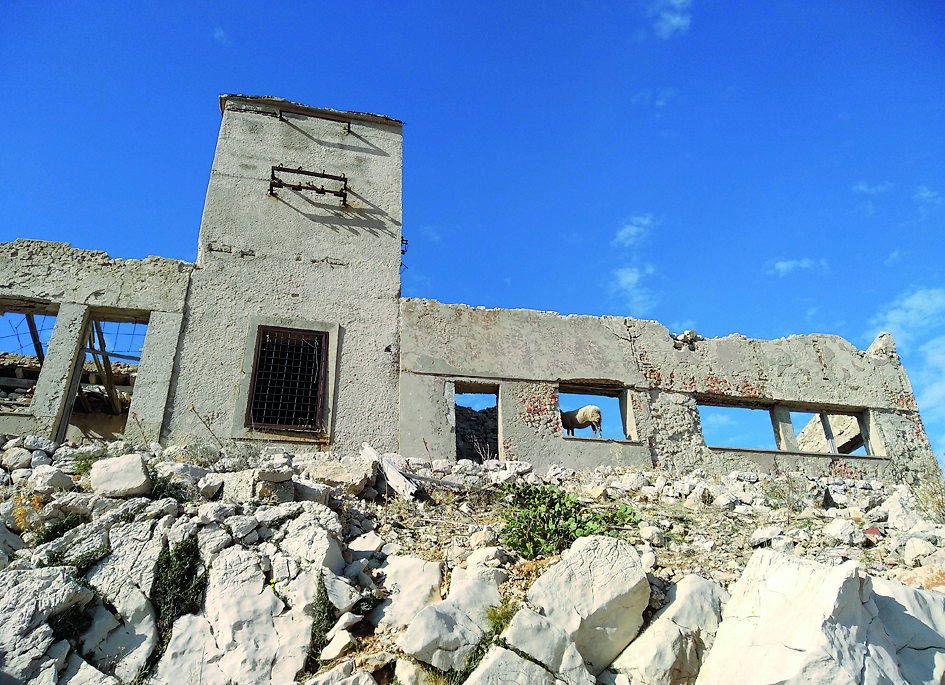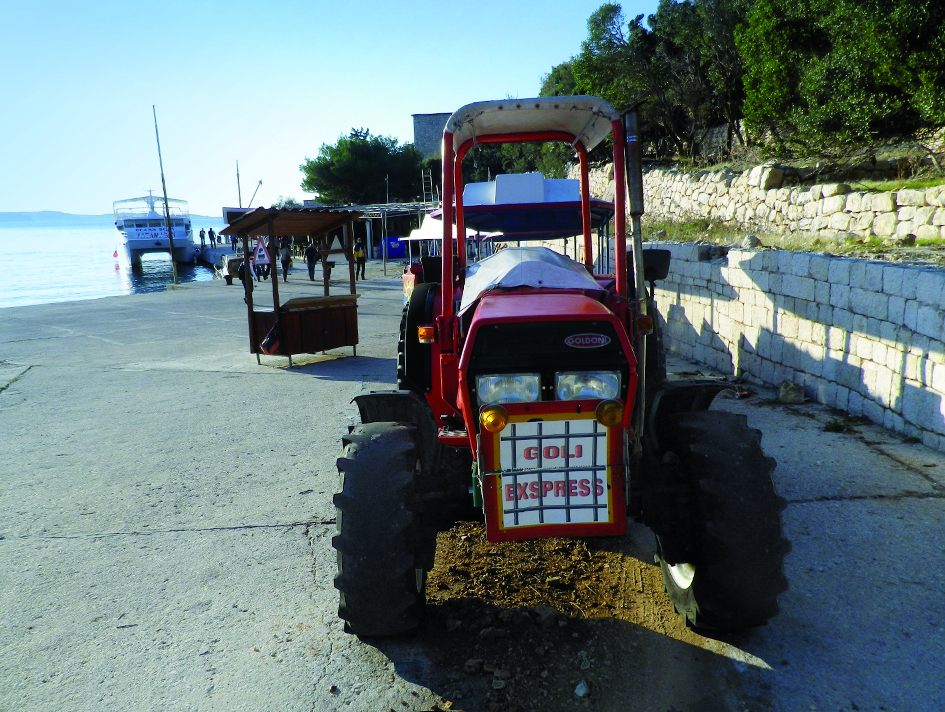Goli otok in the contemporary Croatian culture of remembrance
Goli Otok is one of the places of greatest historical and symbolic significance in contemporary Croatian history. The inhospitable island in the shadow of the Velebit mountain bears the stamp of having been the central site of the Yugoslavian Communist regime’s repression against dissenters. Still, despite its historical and symbolic significance, only derelict, dilapidated buildings decaying in the island’s stony landscape serve as an indication of the camp, and later the prison’s, former existence. The more careful visitor to the island will notice several informational displays, or commemorative plaques dedicated to the victims, as well as tourist and hospitality features of highly questionable appropriateness. At this stage one can only dream of a museum and educational institution that would make Goli Otok its subject-matter, and be based on professional scholarly research, museological, and educational standards.
The destruction of the erstwhile camp, and later prison, vividly illustrates the relationship of the Croatian state and Croatian society towards Goli Otok and its victims. Goli Otok and its victims are today just one of a number of secondary issues in the culture of remembrance, left to the care of the few enthusiasts most commonly tied by family history to the painful subjects. Considering the importance of addressing dictatorships in building a democratic political culture, as well as the prominent role of Communist repression in the culture of remembrance of the majority of contemporary post-communist societies in Europe, the question arises why is this the case.
The reasons for the modest visibility of Goli Otok in Croatian culture are manifold. Speaking of how marginally represented the subject of Goli Otok is in the Croatian culture of remembrance, and the rare expressions of empathy towards the victims, one should say for a start that the ambivalent relationship towards the victims of the site dates back to the period of Socialist Yugoslavia. A combination of ignorance as to the circumstances of the arrests, deportations and the conditions in which the inmates lived on the one hand, and the fear of Soviet invasion and its consequences on the other, has resulted in suspicious questions that continue to shape public opinion on this topic to this day. Some of the questions are: were the inmates on Goli Otok political prisoners or common criminals? If they were political prisoners, were they really fervent backers of Stalin? If they were Stalinists, whatever else could have been done other than to intern them at an isolated place? If they were not Stalinists, how did they even find themselves in the situation where they would be arrested and imprisoned?
It is a fact that some of the inmates on Goli Otok were fervent followers of Stalin, which complicates the situation with recognising the victim status of those inmates who only ended up on Goli Otok because they were maliciously denounced as alleged supporters of the Cominform Resolution. The political elites of Communist Yugoslavia sought to conceal, or justify political repression against their opponents, which partly explains the ambivalent relationship towards Goli Otok in Socialist Yugoslavia. Silence, and the arbitrary construction of justifications and defamation of political adversaries are the legitimation strategies of every dictatorship.

Photograph: Boris Stamenić
After the closing of the prisons and the departure of the last prisoners in the late eighties, the plan was to build a tourist colony on the island, but plans to develop tourism on the island were interrupted by the outbreak of the war in Croatia in 1991. Although outside the area directly affected by the military conflict, the facilities belonging to the former prison on Goli Otok were thoroughly pillaged, laid waste to and left to be forgotten. Farmers from neighbouring settlements use Goli Otok to graze their sheep, which can wander around the island unmolested.
However, the answer to the question why have the victims of political repression on Goli Otok are still not met with unambiguous respect and broad social recognition in today’s democratic, post-communist order, requires a more detailed understanding of the contemporary Croatian culture of remembrance and the ideological framework of contemporary Croatian society.
The first reason for the marginalisation of Goli Otok in the Croatian culture of remembrance lies in the ethnic composition of the inmate population. After 1990, an ethnocentric politics of history prevailed in the post-communist societies. The relatively low proportion of Croats among the inmates means it does not qualify as a site of national suffering.
The other reason lies in the victims’ ideological orientation. Regardless of whether they were or were not supporters of the Cominform Resolution, many inmates were staunch communists, Yugoslavians and veterans of the People’s Liberation War. This fact has also had a negative effect on their perception among part of Croatian society. Due to the ideological orientation of a large number of prisoners, Goli Otok does not fit into the new historical narratives. Although publicly recognised and accepted as a symbol of repression in Communist Yugoslavia, Goli Otok does not represent a pivotal element of the anti-communist discourse in Croatia, which consequently reduces its general visibility.
The third reason for the marginalisation of Goli Otok in the Croatian culture of remembrance lies with the Croatian War of Independence (1991-1995), that is, the fact that while it was still going on, it was affirmed as the central value and identity symbol of Croatian society. War in the context of the dissolution of the socialist order and the multinational federation is a collective experience that differentiates Croatia from the majority of European post-communist societies, and partly explains the differences on the issue of the memorialisation of the contemporary past.
On the other hand, it bears emphasising that the multiple experience of wars and ideologically motivated violence in the 20th century in areas that today belong to Croatia is apparent in the slow yet noticeable trend in the pluralisation of the Croatian culture of remembrance and a coexistence between once-irreconcilable antitheses, if only implicitly. Although this is a positive process in principle, the pluralisation of remembrance culture does also result in the perception of competition amongst the victims, and a feeling among a section of the public “that they only care about their own; they don’t see or recognise our victims”, which in turn leads to new divisions and conflict.
The extent to which a section of the public is preoccupied by political violence and its victims can be seen in the bitter comments on web portals and social networks. The anonymity of participants in internet discussions certainly contributes to the radicalism of the expressed views that frequently veer into insults and threats. At the same time, more and more people withdraw from discussions in the public space, whether scared off by hate speech, or with an assertion that neither history nor politics interest them. In such circumstances, the victims of political violence frequently fade into the background, or become entirely irrelevant.
It is positive that representatives of the authorities, or at least their envoys, can be seen at anniversary commemorations on Goli Otok. Representatives of the political institutions of the Republic of Croatia most frequently visit Goli Otok on 23 August, the International Day of Remembrance for Victims of Totalitarian and Authoritarian Regimes. However, it is one thing to send envoys with wreaths, and quite another to build a museum and educational infrastructure, with professional staff and programmes. The path between the two is very long, and requires significant investment and a readiness on the part of various political and social actors to support this process.
In spite of there being no memorial institution and the accompanying features, interest in seeing Goli Otok among local and foreign visitors has led to the development of a tourism infrastructure organised by entrepreneurs from nearby towns on Krk and Rab, and in Senj and Jurjevo. The former camp, that is, the prison on Goli Otok is thus used to advertise excursions and crafted souvenirs that trivialise the suffering of the Goli Otok prisoners. Visitors to the island can thus ride around the rocky paths in a trailer pulled by a tractor bearing the sign, “Goli Exspress” [sic]. Visitors can also buy refreshments at a bistro called “Pržun”, the local colloquial word for “prison”. The island is also occasionally visited by so-called “party boats” playing loud music.

Photograph: Boris Stamenić, 2018
